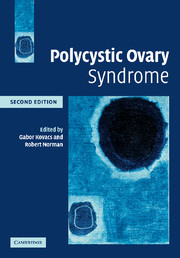Book contents
- Frontmatter
- Contents
- List of contributors
- 1 Introduction: Polycystic ovary syndrome is an intergenerational problem
- 2 Introduction and history of polycystic ovary syndrome
- 3 Phenotype and genotype in polycystic ovary syndrome
- 4 The pathology of the polycystic ovary syndrome
- 5 Imaging polycystic ovaries
- 6 Insulin sensitizers in the treatment of polycystic ovary syndrome
- 7 Long-term health consequences of polycystic ovary syndrome
- 8 Skin manifestations of polycystic ovary syndrome
- 9 Lifestyle factors in the etiology and management of polycystic ovary syndrome
- 10 Ovulation induction for women with polycystic ovary syndrome
- 11 Laparoscopic surgical treatment of infertility related to PCOS revisited
- 12 In vitro fertilization and the patient with polycystic ovaries or polycystic ovary syndrome
- 13 Role of hyperinsulinemic insulin resistance in polycystic ovary syndrome
- 14 Novel treatments for polycystic ovary syndrome, including in vitro maturation
- 15 The pediatric origins of polycystic ovary syndrome
- 16 Fetal programming of polycystic ovary syndrome
- 17 Adrenocortical dysfunction in polycystic ovary syndrome
- 18 Polycystic ovary syndrome in Asian women
- 19 Obesity surgery and the polycystic ovary syndrome
- 20 Nutritional aspects of polycystic ovary syndrome
- Index
- References
3 - Phenotype and genotype in polycystic ovary syndrome
Published online by Cambridge University Press: 29 September 2009
- Frontmatter
- Contents
- List of contributors
- 1 Introduction: Polycystic ovary syndrome is an intergenerational problem
- 2 Introduction and history of polycystic ovary syndrome
- 3 Phenotype and genotype in polycystic ovary syndrome
- 4 The pathology of the polycystic ovary syndrome
- 5 Imaging polycystic ovaries
- 6 Insulin sensitizers in the treatment of polycystic ovary syndrome
- 7 Long-term health consequences of polycystic ovary syndrome
- 8 Skin manifestations of polycystic ovary syndrome
- 9 Lifestyle factors in the etiology and management of polycystic ovary syndrome
- 10 Ovulation induction for women with polycystic ovary syndrome
- 11 Laparoscopic surgical treatment of infertility related to PCOS revisited
- 12 In vitro fertilization and the patient with polycystic ovaries or polycystic ovary syndrome
- 13 Role of hyperinsulinemic insulin resistance in polycystic ovary syndrome
- 14 Novel treatments for polycystic ovary syndrome, including in vitro maturation
- 15 The pediatric origins of polycystic ovary syndrome
- 16 Fetal programming of polycystic ovary syndrome
- 17 Adrenocortical dysfunction in polycystic ovary syndrome
- 18 Polycystic ovary syndrome in Asian women
- 19 Obesity surgery and the polycystic ovary syndrome
- 20 Nutritional aspects of polycystic ovary syndrome
- Index
- References
Summary
Introduction
Polycystic ovary syndrome (PCOS) is the most common but least understood endocrinopathy. Although a major genetic contribution is suspected, there have been no clear genes or family of genes identified that cause or contribute to PCOS. This may be due to both the difficulty in phenotyping as well as the limited genotyping studies that have been performed to date. The diagnosis of PCOS has traditionally been based on a history of oligomenorrhea and/or hyperandrogenism, either clinical, i.e., most commonly hirsutism, or biochemical, i.e., elevated circulating total or bioavailable androgens; and/or polycystic ovaries. The criteria that emerged from the 1990 National Institute of Child and Human Development (NIH-NICHD) conference identified PCOS as unexplained hyperandrogenic chronic anovulation, making it in essence a diagnosis of exclusion (Zawadski and Dunaif 1992). The “consensus” definition did not include the polycystic ovary morphology, most commonly today found on ultrasound consisting of multiple 2–8 mm subcapsular preantral follicles and increased ovarian volume (Balen et al. 2003). These ultrasound criteria were recently incorporated in the revised 2003 Rotterdam criteria which require two out of the three above cardinal stigmata for PCOS: oligomenorrhea, hyperandrogenism, and/or polycystic ovaries (The Rotterdam ESHRE/ASRM-Sponsored PCOS Consensus Workshop Group 2004).
None of these expert-generated definitions include insulin resistance, a common but not inevitable finding in PCOS. This diagnostic dilemma has hampered clinical and genetic studies of PCOS. The larger the number of distinct phenotypes within the affected category, the more complex the genetic analysis and the greater the likelihood that investigators using different diagnostic criteria will arrive at different conclusions.
- Type
- Chapter
- Information
- Polycystic Ovary Syndrome , pp. 25 - 41Publisher: Cambridge University PressPrint publication year: 2007
References
- 3
- Cited by

